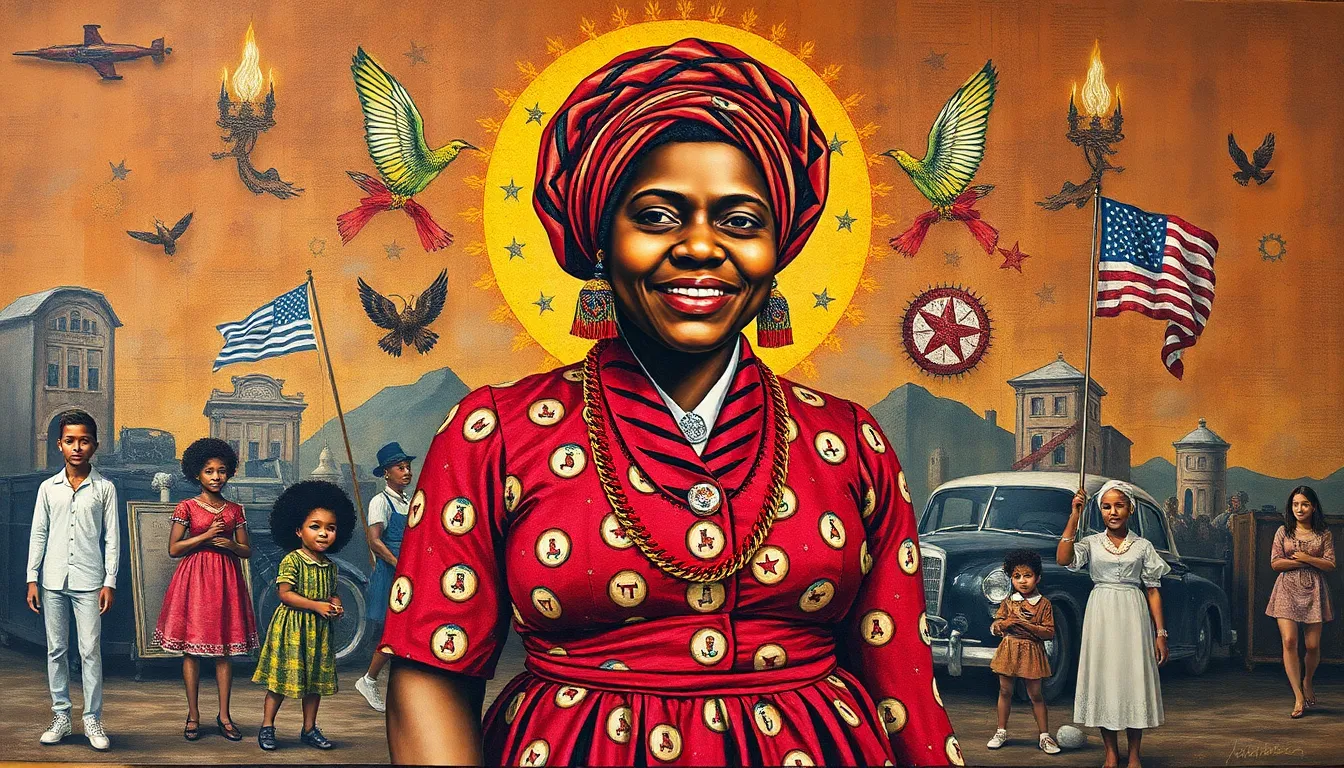Betye Saar’s mixed media project, The Liberation of Aunt Jemima, is more than just an artistic endeavor; it’s a bold statement that challenges stereotypes and reclaims narratives. Imagine taking a familiar figure, one that’s been used and misused for decades, and flipping the script. That’s exactly what Saar does, transforming Aunt Jemima from a symbol of oppression into a powerful emblem of empowerment and liberation.
The Intent of Betye Saar’s Mixed Media Project The Liberation of Aunt Jemima is to __________.
Betye Saar stands as a prominent figure in contemporary art, known for her powerful mixed media projects. Her work often explores themes of race, identity, and history. Focusing on The Liberation of Aunt Jemima, Saar presents a critique of racial stereotypes. This project serves as a pivotal reflection on how commonplace imagery can shape societal perceptions.
Saar uses a range of materials, including found objects and traditional art elements, to construct her narratives. In The Liberation of Aunt Jemima, she reclaims the Aunt Jemima figure, transforming it from a symbol of oppression into one of empowerment. This reinterpretation profoundly challenges viewers to reconsider their understanding of cultural icons.
Artistic methods employed in her pieces often include collage and assemblage. These techniques allow her to weave together various histories and narratives, creating a rich dialogue around race and gender. Influences from African American culture and spirituality permeate her work, enhancing its emotional depth.
The Liberation of Aunt Jemima exemplifies Saar’s commitment to social commentary through art. Symbols associated with servitude and subservience undergo significant transformation as Saar infuses them with new meaning. This shift encourages a dialogue about the reclamation of identity and the power of representation in art.
Throughout her career, Saar has remained dedicated to addressing societal issues. Each project contributes to ongoing conversations surrounding race and equity. Her work inspires viewers to confront biases and engage with the complexities of cultural representation.
Significance of “The Liberation of Aunt Jemima”

The Liberation of Aunt Jemima holds significant artistic and cultural value. This project actively confronts stereotypes and reclaims historical narratives, inviting viewers to engage with its multi-layered meanings.
Historical Context
Art reflects societal values, and Saar’s work critiques the oppressive origins of the Aunt Jemima image. Rooted in the post-Civil War era, the character represents the commodification of Black womanhood. Slavery, segregation, and racial caricatures inform her depiction. During the 19th and 20th centuries, Aunt Jemima became a staple in American culture, reinforcing harmful stereotypes. Saar’s reinterpretation serves as a response to these historical injustices, aiming to shed light on the complexities of race and identity. By transforming the character into a symbol of empowerment, Saar initiates conversations about the impacts of these historical narratives on contemporary society.
Cultural Implications
Cultural representation in art shapes perceptions and drives dialogue. Saar’s project challenges dominant narratives by redefining the Aunt Jemima figure, promoting empowerment rather than submission. Imagery in The Liberation of Aunt Jemima uses symbolism to critique societal norms and explore themes of resilience. Reclaiming this image opens up discussions about identity and representation. Viewers can reflect on the ongoing struggle for equity and justice, inspired by Saar’s bold approach. Through her work, Saar not only highlights cultural issues but also encourages audiences to confront their biases and assumptions.
Mixed Media Techniques Used
Betye Saar’s work in The Liberation of Aunt Jemima employs various mixed media techniques that create a rich, immersive experience.
Materials and Methods
Saar utilizes found objects to construct her pieces, integrating textiles, photographs, and printed materials. Collage techniques play a crucial role, as she combines these disparate elements to create visual narratives. Assemblage also features prominently, where three-dimensional constructs convey complex meanings. Her choice of vibrant colors and unique textures enhances the emotional impact of the artwork. Utilization of everyday materials appeals to the viewer’s familiarity while challenging traditional art forms.
Symbolism in Saar’s Artwork
Symbolism in Saar’s artwork conveys deeper themes of identity and empowerment. The Aunt Jemima figure transforms from a stereotype into a representation of strength and resilience. Iconography reflects historical context, evoking conversations about race and representation. Each material choice carries significance, reinforcing critiques of societal norms. Reclaimed imagery speaks to personal and collective histories, inviting viewers to rethink preconceived notions. The interplay between objects amplifies messages of liberation, allowing for an exploration of the complexities surrounding cultural identity.
The Intent of Betye Saar’s Mixed Media Project
Betye Saar’s project The Liberation of Aunt Jemima serves both as an artistic expression and a cultural critique. It focuses on redefining narratives that surround the Aunt Jemima figure, moving beyond stereotypes to highlight empowerment.
Challenging Stereotypes
Artworks in The Liberation of Aunt Jemima confront stereotypes that have historically marginalized Black women. Saar’s reinterpretation challenges the narrative of servitude associated with Aunt Jemima, instead presenting her as a figure of strength. Viewers engage with visual elements that provoke thought around societal perceptions. By utilizing mixed media, Saar incorporates found objects that symbolize resistance against these stereotypes. This challenging of preconceived notions inspires discussions about race and identity, promoting a deeper understanding of the impact of cultural imagery.
Empowering Black Women
Empowerment emerges as a central theme in Saar’s mixed media project. The transformation of Aunt Jemima into a potent symbol of liberation reclaims agency for Black women. Through layers of imagery and materials, Saar illustrates resilience in the face of oppression. Each element within the artwork contributes to a greater narrative that emphasizes strength and dignity. As viewers encounter the pieces, they are prompted to reflect on the complexities of identity representation. Saar’s work champions the voices of Black women, encouraging them to embrace their narratives and challenge societal norms surrounding them.
Reception and Impact
Betye Saar’s The Liberation of Aunt Jemima has garnered significant acclaim since its debut, resonating deeply within the art community and beyond. Critics recognize the work as a powerful commentary on race and identity. Many view it as an essential critique of the commodification of Black womanhood.
Exhibitions featuring Saar’s project often spark discussions surrounding cultural representation. Visitors to galleries and museums engage in conversations that reflect on historical stereotypes. Art historians frequently cite this work as an example of how contemporary artists address social issues through their craft.
Saar’s integration of mixed media techniques enhances both the visual impact and the thematic depth of the piece. Her use of collage calls attention to the complexity of identity narratives. Viewers often respond positively to the emotive quality of the materials, highlighting how each element contributes to the overarching message of empowerment.
Impact extends beyond the gallery walls, influencing academic discourse. Scholars analyze the implications of Saar’s reinterpretation, exploring its relevance in discussions of feminism and race. Audiences frequently report that the project encourages personal reflection on biases and societal norms.
In social contexts, her work has become a catalyst for change. Activists advocate for the re-examination of cultural symbols, inspired by Saar’s challenge to traditional narratives. Many participants in community discussions credit the project with motivating them to confront and engage with the complexities of cultural identity.
Overall, the reception of The Liberation of Aunt Jemima illustrates the pivotal role art plays in social critique. Its impact continues to inspire future generations of artists and activists alike. The work maintains its potency, inviting ongoing dialogue about heritage, representation, and empowerment.
Conclusion
Betye Saar’s The Liberation of Aunt Jemima stands as a powerful testament to the transformative potential of art. By reimagining a historically loaded figure, Saar not only challenges entrenched stereotypes but also champions the narratives of Black women. This project encourages viewers to engage critically with cultural representations and confront their own biases.
Through her innovative use of mixed media, Saar crafts a dialogue around identity and empowerment, inviting audiences to reflect on the complexities of race and history. The impact of her work resonates far beyond the canvas, inspiring discussions that promote understanding and equity. Ultimately, Saar’s artistic vision paves the way for future generations to explore and reclaim their narratives in a society that often overlooks them.









